 W
WThe 75 mm gun model of 1917 was an interim measure, based on the British QF 18-pounder, produced by the United States in World War I after it had decided to switch from 3-inch (76 mm) to 75 mm calibre for its field guns.
 W
WThe 155 mm gun M1 was a 155 millimeter caliber field gun developed and used by the United States military. Nicknamed "Long Tom", it was produced in M1 and M2 variants, later known as the M59. Developed to replace the Canon de 155mm GPF, the gun was deployed as a heavy field weapon during World War II and the Korean War, and also classed as secondary armament for seacoast defense. The gun could fire a 100 lb (45 kg) shell to a maximum range of 14 mi (23 km), with an estimated accuracy life of 1,500 rounds.
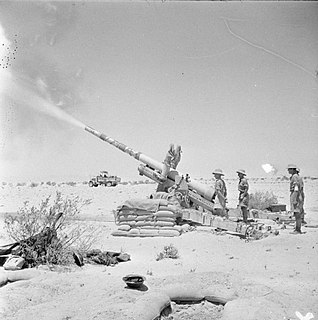 W
WThe BL 4.5 inch medium gun was a British gun used by field artillery in the Second World War for counter-battery fire. Developed as a replacement for the BL 60-pounder gun it used the same carriage as the BL 5.5-inch medium gun but fired a lighter round a further distance.
 W
WThe BL 5.5-inch gun was a British artillery gun introduced during the middle of the Second World War to equip medium batteries.
 W
WThe Ordnance BL 6 inch 26cwt howitzer was a British howitzer used during World War I and World War II. The qualifier "26cwt" refers to the weight of the barrel and breech together which weighed 26 long hundredweight (1.3 t).
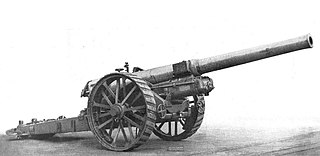 W
WThe British BL 6-inch gun Mk XIX was introduced in 1916 as a lighter and longer-range field gun replacement for the obsolescent BL 6-inch gun Mk VII.
 W
WThe BL 7.2-inch howitzer was a heavy artillery piece used by the British Army throughout the Second World War.
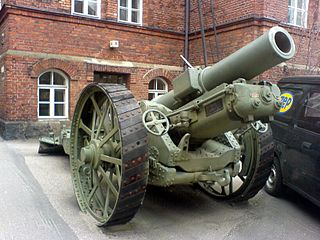 W
WThe BL 8-inch howitzer Marks VI, VII and VIII were a series of British artillery siege howitzers on mobile carriages of a new design introduced in World War I. They were designed by Vickers in Britain and produced by all four British artillery manufacturers, but mainly by Armstrong, and one American company. They were the equivalents of the German 21 cm Morser 16 and in British service were used similarly to the BL 9.2-inch howitzer, but were quicker to manufacture, and more mobile. They delivered a 200 lb (91 kg) shell to 12,300 yards (11.2 km). They had limited service in the British Army in World War II before being converted to the new 7.2-inch (180 mm) calibre. They also equipped a small number of Australian and Canadian batteries in World War I and by the US Army in that war. They were used in small numbers by other European armies.
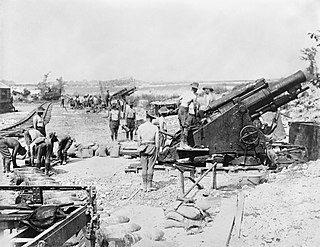 W
WThe Ordnance BL 9.2-inch howitzer was a heavy siege howitzer that formed the principal counter-battery equipment of British forces in France in World War I. It equipped a substantial number of siege batteries of the Royal Garrison Artillery. It remained in service until about the beginning of World War II.
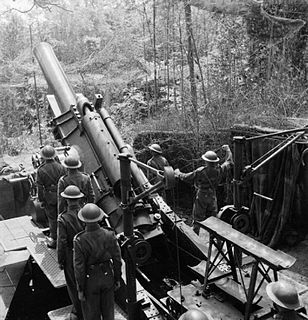 W
WThe Ordnance BL 12-inch howitzer was a scaled-up version of the successful BL 9.2-inch siege howitzer.
 W
WThe Ordnance BL 60-pounder was a British 5 inch (127 mm) heavy field gun designed in 1903–05 to provide a new capability that had been partially met by the interim QF 4.7 inch Gun. It was designed for both horse draft and mechanical traction and served throughout the First World War in the main theatres. It remained in service with British and Commonwealth forces in the inter-war period and in frontline service with British and South African batteries until 1942 being superseded by the BL 4.5 inch Medium Gun.
 W
WThe Littlejohn adaptor was a device that could be added to the British QF 2 pounder (40 mm) anti-tank gun. It was used to extend the service life of the 2-pounder during the Second World War by converting it to squeeze bore operation. "Littlejohn" came from the calque, i.e. literal anglicization, of the name of František Janeček, the Czech designer and factory owner who had been working on the squeeze-bore principle in the 1930s and his son František Karel Janeček, who had brought his know-how to Britain after fleeing from German-occupied Czechoslovakia.
 W
WThe 75mm Pack Howitzer M1 was an artillery piece used by the United States. It was designed in the 1920s to meet a need for a howitzer that could be moved across difficult terrain. The gun and carriage were designed so that it could be broken down into several pieces to be carried by pack animals. The gun saw combat in World War II with the United States Army, with the United States Marine Corps, and was also supplied to foreign forces.
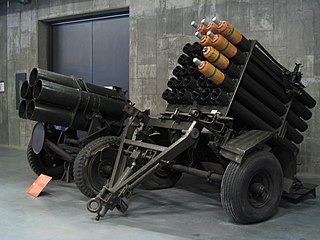 W
WMattress was the term applied to ground-based British-devised multiple rocket launchers during World War II. Compared with the German and Soviet forays into this area the western Allies deployed these weapons late in the war. Nevertheless, they did see useful service as artillery support during the crossings of the Rhine and the Scheldt rivers.
 W
WThe Ordnance QF 3 pounder gun was a 47 mm British tank gun based on the Ordnance QF 3 pounder Vickers naval gun, mounted on Vickers-built tanks in the 1920s and 1930s. The gun was produced in 31 calibre and 40 calibre versions. The weapon only fired a solid shot, and was stated in the requirements of the A6 series of Vickers Medium tanks to have the ability to penetrate the armour of contemporary hostile tanks at a range of 1000 yards. The Vickers Medium Mark I was equipped with the Ordnance Quick Firing 2cwt Mark I version of the weapon, whilst from the Vickers Medium Mark II the Mark II version of the 3-pounder was utilized.
 W
WThe Ordnance Quick-Firing 17-pounder was a 76.2 mm (3 inch) gun developed by the United Kingdom during World War II. It was used as an anti-tank gun on its own carriage, as well as equipping a number of British tanks. Used with the APDS shot, it was capable of defeating all but the thickest armour on German tanks. It was used to 'up-gun' some foreign-built vehicles in British service, notably to produce the Sherman Firefly variant of the US M4 Sherman tank, giving British tank units the ability to hold their own against their German counterparts. In the anti-tank role, it was replaced after the war by the 120 mm BAT recoilless rifle. As a tank gun, it was succeeded by the 84 mm 20 pounder.
 W
WThe Ordnance QF 25-pounder, or more simply 25-pounder or 25-pdr, was the major British field gun and howitzer during the Second World War, possessing a 3.45-inch (87.6 mm) calibre. It was introduced into service just before the war started, combining both high-angle and direct-fire abilities, a relatively high rate of fire, and a reasonably lethal shell in a highly mobile piece. It remained the British Army's primary artillery field piece well into the 1960s, with smaller numbers serving in training units until the 1980s. Many Commonwealth of Nations countries used theirs in active or reserve service until about the 1970s and ammunition for the weapon is currently being produced by Pakistan Ordnance Factories. Initial production was slow, but by 1945, over 12,000 had been manufactured. The 25-pounder was probably the most outstanding field artillery piece used by British and Commonwealth forces in the Second World War, being durable, easy to operate and versatile.
 W
WThe Ordnance QF 32 pounder or (32-pdr) was a British 94 mm gun, initially developed as a replacement for the Ordnance QF 17-pdr anti-tank gun.
 W
WThe Ordnance QF 2-pounder, or simply "2 pounder gun", was a 40 mm (1.575 in) British anti-tank and vehicle-mounted gun employed in the Second World War.
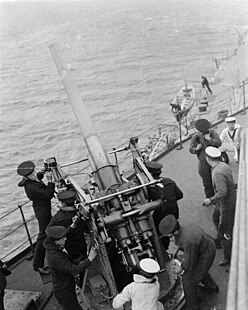 W
WThe QF 3 inch 20 cwt anti-aircraft gun became the standard anti-aircraft gun used in the home defence of the United Kingdom against German airships and bombers and on the Western Front in World War I. It was also common on British warships in World War I and submarines in World War II. 20 cwt referred to the weight of the barrel and breech, to differentiate it from other "3 inch" guns. While other AA guns also had a bore of 3 inches (76 mm), the term "3 inch" was only ever used to identify this gun in the World War I era, and hence this is what writers are usually referring to by "3 inch AA gun".
 W
WOrdnance QF 3 inch howitzer was a howitzer fitted to British cruiser and infantry type tanks of the Second World War so they could fire a smoke shell in "close support" of other tanks or infantry. HE shells were also available. Earlier British tanks were fitted with a 3.7 in howitzer.
 W
WOrdnance, QF 3.7-inch howitzer is a mountain gun, used by British and Commonwealth armies in the First and Second World Wars, and between the wars.
 W
WThe QF 3.7-inch AA was Britain's primary heavy anti-aircraft gun during World War II. It was roughly the equivalent of the German 88 mm FlaK and American 90 mm, but with a slightly larger calibre of 3.7 inches, approximately 94 mm. Production began in 1937 and it was used throughout World War II in all theatres except the Eastern Front. It remained in use after the war until AA guns were replaced by guided missiles beginning in 1957.
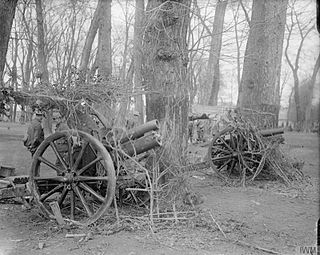 W
WThe Ordnance QF 4.5-inch howitzer was the standard British Empire field howitzer of the First World War era. It replaced the BL 5-inch howitzer and equipped some 25% of the field artillery. It entered service in 1910 and remained in service through the interwar period and was last used in the field by British forces in early 1942. It was generally horse drawn until mechanisation in the 1930s.
 W
WThe QF 4.5 inch gun has been the standard medium-calibre naval gun used by the Royal Navy as a medium-range weapon capable of use against surface, aircraft and shore bombardment targets since 1938. This article covers the early 45-calibre family of guns up to the 1970s. For the later unrelated 55-calibre Royal Navy gun, see 4.5 inch Mark 8 naval gun.
 W
WThe Ordnance Quick-Firing 6-pounder 7 cwt, or just 6-pounder, was a British 57 mm gun, serving during the Second World War as a primary anti-tank gun of both the British and United States Army. It was also used as the main armament for a number of armoured fighting vehicles.
 W
WThe Ordnance Quick-Firing 17-pounder was a 76.2 mm (3 inch) gun developed by the United Kingdom during World War II. It was used as an anti-tank gun on its own carriage, as well as equipping a number of British tanks. Used with the APDS shot, it was capable of defeating all but the thickest armour on German tanks. It was used to 'up-gun' some foreign-built vehicles in British service, notably to produce the Sherman Firefly variant of the US M4 Sherman tank, giving British tank units the ability to hold their own against their German counterparts. In the anti-tank role, it was replaced after the war by the 120 mm BAT recoilless rifle. As a tank gun, it was succeeded by the 84 mm 20 pounder.
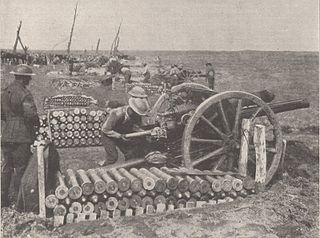 W
WThe Ordnance QF 18-pounder, or simply 18-pounder gun, was the standard British Empire field gun of the First World War-era. It formed the backbone of the Royal Field Artillery during the war, and was produced in large numbers. It was used by British Forces in all the main theatres, and by British troops in Russia in 1919. Its calibre (84 mm) and shell weight were greater than those of the equivalent field guns in French (75 mm) and German (77 mm) service. It was generally horse drawn until mechanisation in the 1930s.
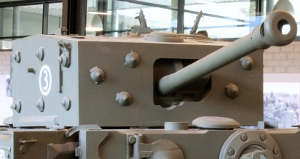 W
WThe Ordnance QF 75 mm, abbreviated to OQF 75 mm, was a British tank gun of the Second World War. It was obtained by boring out the Ordnance QF 6-pounder 57 mm anti-tank gun to 75 mm, to give better performance against infantry targets in a similar fashion to the 75 mm M3 gun fitted to the American Sherman tank. The QF came from "quick-firing", referring to the use of ammunition where the shell has a fixed cartridge. The gun was also sometimes known as ROQF from Royal Ordnance Quick-Firing.
 W
WThe Ordnance QF 95-mm howitzer was a British howitzer built in two versions during the Second World War. The tank howitzer version was accepted for service use, but the infantry version was not.
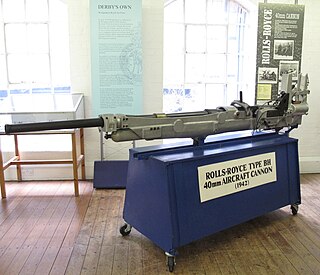 W
WThe Rolls-Royce 40mm Cannon was a project first proposed in late 1938 to produce a cannon for mounting in aircraft which could cause sufficient damage to bring down a large bomber. It was also envisioned to be a suitable weapon for destroying tanks from the air. Experimental versions of the cannon were produced including some with a magazine or belt feed for the ammunition. Examples were fitted to a Beaufighter and Hurricane for testing, although never used in action. Continued development of the aircraft cannon to iron out problems came to an end in 1943 when the Air Ministry lost interest in it and had started to favor the rocket projectile as its aircraft anti-tank weapon of choice.
 W
WThe Smith Gun was an ad hoc anti-tank artillery piece used by the British Army and Home Guard during the Second World War.
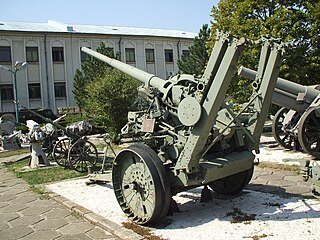 W
WThe Vickers Model 1931 was a British anti-aircraft gun used during the Second World War. The design was rejected by the British and Vickers exported the gun worldwide during the 1930s. Romania bought a license for 100 in 1936, although hundreds more were built during the war. The second batch of 100 pieces was started in July 1941, the production rate being of 5 pieces per month as of October 1942. Denmark also bought a license. Belgium, the Netherlands, Lithuania, Turkey, Switzerland and China bought numbers of guns directly from Vickers. Finland bought a dozen to help reduce balance of payment problems with the British in 1936. The Finnish guns were chambered in their standard 76.2 mm (3 in) caliber. Those weapons captured after the German conquest of Europe were taken into Wehrmacht service as the 7.5 cm Flak M 35(h) or 7.5 cm Flak M 35(d). Similarly the Soviet Union used those guns it captured from Lithuania. Supposedly it saw limited British service with Home Defense "barrage units" 1940—43.